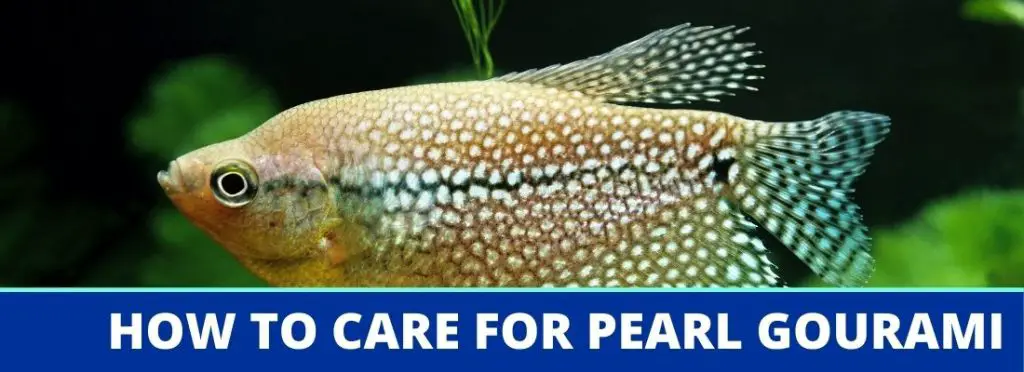Gourami are a popular freshwater fish species for aquarists to keep. Pearl gourami, in particular, are a fun variety that really add a lot of visual appeal to your tropical fish tank, as well as add some fun personality to the mix.
These unique, fun little fish are always a boon to any ecosystem (in which they fit, at least!) and add some beauty to the aquarium while not being crazy hard to care for.
They are a little tricky – rated as moderate – but most folks can care for them, even beginners, if they’ll carefully study and learn how to best do the work.
Let’s take a look.
Quick Intro to Pearl Gourami
| Family: | Osphronemidae |
| Scientific Name: | Trichogaster leerii |
| Common Names: | Pearl gourami, mosaic gourami, lace gourami, diamond gourami, leeri gourami |
| Care Level: | Moderate |
Natural Habitat, Identification, and Where to Buy
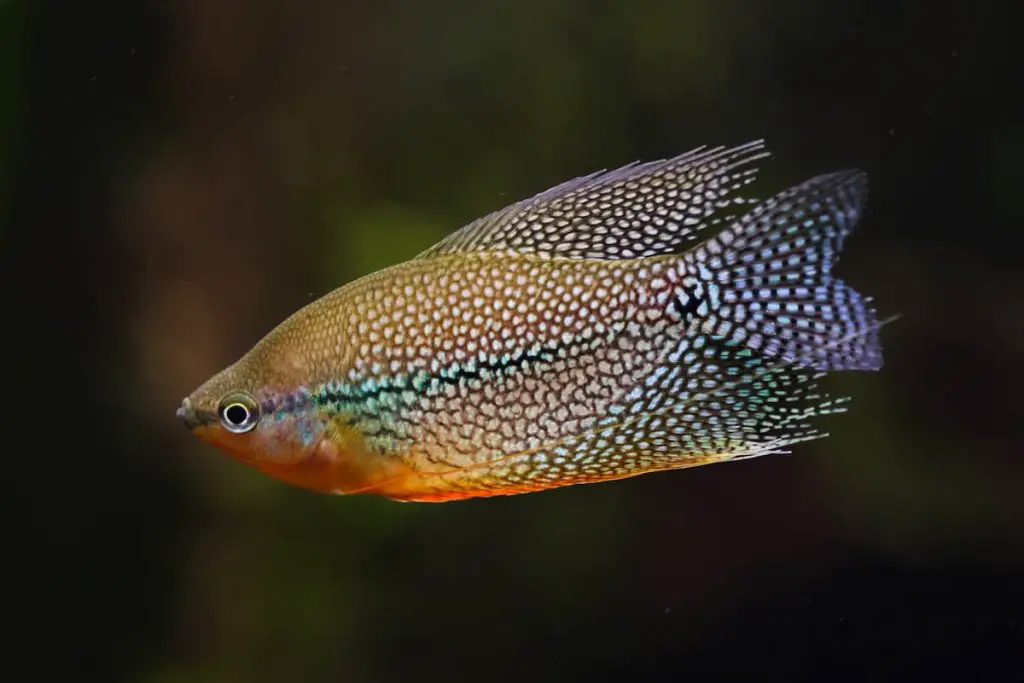
Pearl Gourami is a species of fish that is found in Indonesia, Malaysia, Thailand, and the islands of Sumatra and Borneo. They love water from the lowland swamps near sears that are high in acidity.
The vegetation in the water is something the fish love and a place they can hide when needed. There have been active attempts to introduce this species of fish into the wild in both Colombia and Singapore.
This species of fish has pearl and brown flakes on its skin. This has caused people to give it various nicknames such as lace, mosaic, diamond, and pearl. By far pearl is its most common and popular name.
This species of fish has been listed as Near Threatened on the Red List of Threatened Species by the International Union for Conservation of Nature (IUCN).
This species is in danger from their natural ecosystems being disrupted by water management usage and damming. They have also been over-harvested and are in danger due to logging in and around their habitats.
This species looks quite similar to other fish in its family. Their mouth is small and turned upward and has brown and pearl flecks covering its skin.
They have an elongated body and are laterally compressed. Their ventral fins are long and thin and look like they are long feelers.
You can find Pearl Gourami in many pet stores, including a number online.
Optimal Water Conditions for Pearl Gourami
| Water Temperature: | 77 F to 82 F |
| Water Flow Rate: | Slow |
| pH: | 5.5 to 7.5 |
| Water Hardness: | 2 to 30 dH |
Tank Setup
| Minimum Tank Size: | 30 gallons |
| Optimal Tank Size: | 45 gallons |
| Optimal Tank Shape: | Rectangular tank |
| Recommended Filter Type: | An external filter that can allow for water movement without disrupting the surface. |
A happy fish is a healthy fish. One of the best ways to ensure your fish is happy is to design an aquarium that emulates their natural environment.
If you take the time to design a good tank then it will help reduce the stress of your fish, lower the chances of illness and, help prevent your fish from being unwilling to eat their food.
There need to be about six gallons of water for each pearl gourami fish in your tank. It is better to have too much water and understock than overstock your fish tank.
The substrates you use for the bottom of your tank is important. Sand is the best choice if you are wanting to closely duplicate their home.
However, you can also use fine-grained gravel in the place of sand. The pearl gourami will spend most of its time higher in the tank, but at times they will dig into the sand and create caves.
The net part in designing your tank involves finding the right plants to add to your tank.
Expert fish keepers recommend you use live plants so that the fish can have a snack, some fiber, and the added benefit of the plant helping to make the water cleaner.
When considering specific plants, Java Fern and Anacharis are widely suggested by hobbyists.
When you are ready to add water to the tank, while this fish lives in acidic waters in nature those bred in captivity can handle a wider pH range between 6 and 8.
The water temperature needs to be between 77-82°F with a water hardness ranging from 5-15dH.
Creating the Landscape
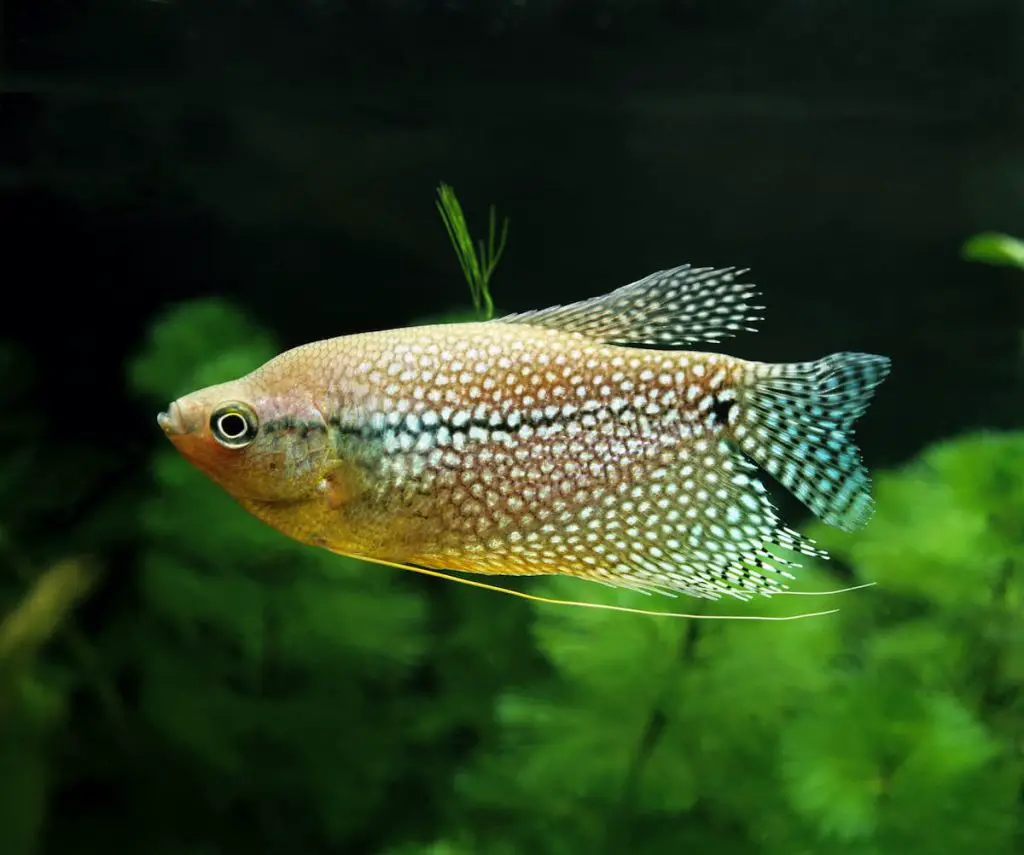
Pearl Gourami are from slow-moving freshwaters in Asia. The waters they live in range from rivers, lakes, and some low lying swamps that have high water acidity. These bodies of water have numerous water qualities in common.
They are all shallow and slower-moving waters that are filled with vegetation and plants. This species of fish likes to use the vegetation as a place to hide and a place to swim around before moving up to the surface for air.
These waterways have substrate full of sand, rocks, and driftwood. These rocks and pieces of driftwood make caves for the fish and surfaces that algae can grow upon.
If you give your Peal Gourami a similar environment to what they would have in the wild, then they will thrive. Having a lot of plants, subdued lighting, and a dark substrate are all ideal choices.
While in nature they live in soft acidic water, they can adapt to a wider range of water conditions. Their adaptability and being a peaceful fish that likes to be around other fish makes them ideal choices for community tanks.
| Best Plants: Java Moss, Watersprite, Hornwort, Crystalwort, Water Lettuce |
Physiological Considerations for Pearl Gourami
| Size: | 4-5 inches |
| Lifespan: | Up to 5 years |
| Temperament: | Peaceful but males may be territorial |
| Preferred Tank Region: | Top, mid-dweller |
| Scale Thickness: | Nothing special to note. |
| Gill Considerations: | Adults breathe with labyrinth organs while fry breathe with gills. |
| Swimbladder Considerations: | They are less susceptible to swim bladder issues than many freshwater fish, but you should still avoid overfeeding them and should maintain a clean fish tank to help ensure they don’t develop these issues. |
| Fin Shape Considerations: | No shape considerations, but pearl gourami are susceptible to fin rot, so keep an eye on their fins for any changes. |
There are a variety of Gourami species and among those, the peal gourami is considered to be the most demanding, this fish is quite sensitive to temperature change, any kind of water contamination, and it has a very timid personality.
Despite accommodations needed there are no specialized equipment needed to keep your fish healthy and happy. All that is needed is to maintain proper tank conditions by keeping a spacious tank that has dim lighting.
An ideal tank sized for your fish is around 40 gallons. A tank that size will allow you to keep around 3-5 different species of fish.
If you decide to go with a smaller tank, remember it will require you to decrease the number about the size of the tank.
It is also important to make sure there will be more females than males so that there will not be any fighting amongst the male population.
The air around the water surface needs to be kept well ventilated warm. This is key to helping to ensure your fish has good health. This means you will need to have a secure lid that can cover your tank.
Author note: The lid not just covers the water to prevent objects from falling into the water, but it also helps to keep up the high humidity and temperature needed for the tank.
As this species of fish can be timid and shy, it needs to have a lot of plants for it to feel safe and comfortable.
When it comes to decorating the fish tank, it is important to use plants with strong roots along the back and sides of the fish tank.
Another good choice is to see floating plants because they allow for additional shows for the fish to take refuge in.
As with any fish tank, having appropriate water filtration, but is important to prevent any extra water flow due to this species preference for slower waters.
While the very bottom substrate does not matter, if you care about how your fish is presented, they look best with the dark-colored substrate.
The only real-time that this species shows aggression is during the breeding and mating process. Most of the aggression is confined to the males. They should be placed in a breeding tank because of this.
Author note: Similar to other gouramis, this fish has an organ they use to breathe and because it’s akin to a lung, this species needs to visit the surface for air.
Society
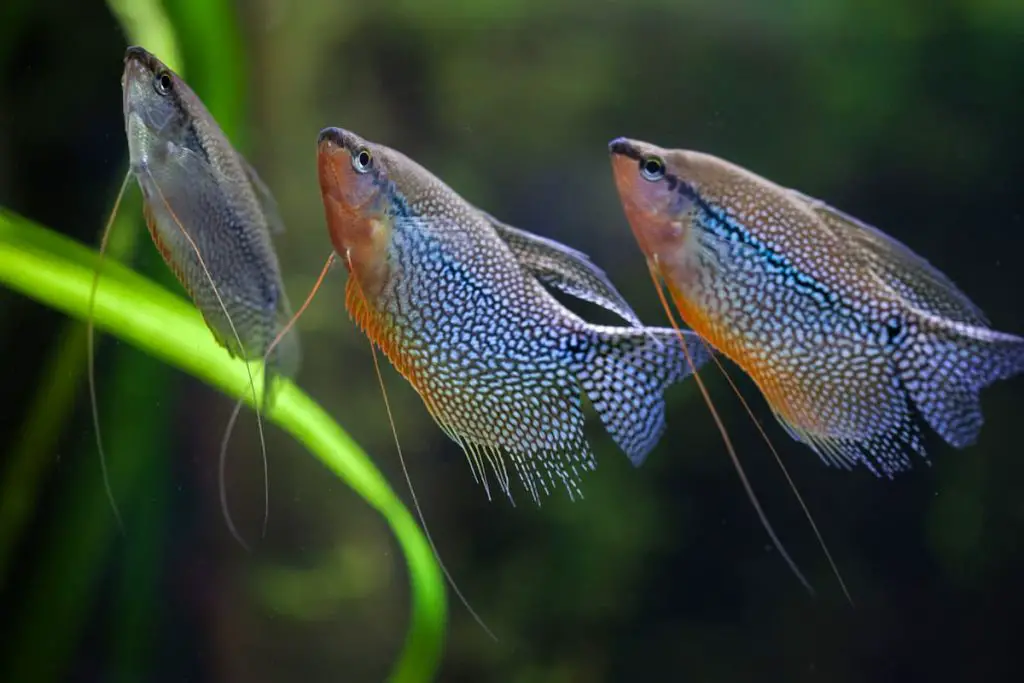
While Pearl Gourami is generally peaceful, except during mating time, it is important to make sure they are not having to share their tank with overly aggressive tankmates.
It is always important to keep fish with others of a similar temperament and size.
When this species of fish is spawning the males become the most aggressive. They will fight other Pearl Gouramis over females and try to scare off any fish they swim to close to their nests.
As this is a schooling fish, it is important to keep it with several fish that are the same species of a similar temperament.
Having other fish to swim around with it will help the fish be less anxious. If you decide to keep multiple Peal Gouramis, it is important to include a mix of several females to one male to reduce the likelihood of aggression.
Due to its need for breathing air, this fish will spend most of its time around the mid and mid to upper levels of the tank.
Despite most fish needing gills, Pearl Gouramis breathe through a labyrinth organ that takes oxygen to the air rather than water.
As this species tends to have high compatibility, several different fish species make for good tank mates. When choosing tank mates for these community fish, you can always consider other types of Gouramis.
Top tip: Other good choices are small and peaceful fish like neon tetras and pearl danios, though they can also do well with some smaller semi-aggressive fish.
The only way you can use bigger fish is if they are peaceful and not prone to aggressive actions. Fish that are overactive or large and swim near the top of your tank will scare and cause stress to your fish.
This stress can cause them to lose their coloration and avoid eating during feeding time.
Loaches and catfish can make for safe additions because these fish species will spend a lot of their time at the bottom level of the tank foraging.
Since the Pearl Gouramis will stick near the top, the two species should not cross paths often. Suggested fish like Corydoras or yo-yo loaches have the right kind of temperament.
Some of the species they’ll house well with include:
- Small Tetras
- Neon Tetras
- Dwarf Cichlids
- Guppies
- Danios
- Platies
- Hatchetfish
- Swordtails
- Kuhli Loaches
- Cory Catfish
- Dwarf Gourami
- Bristlenose Pleco
- Cherry Barbs
Gender, Breeding, and Reproductive Considerations
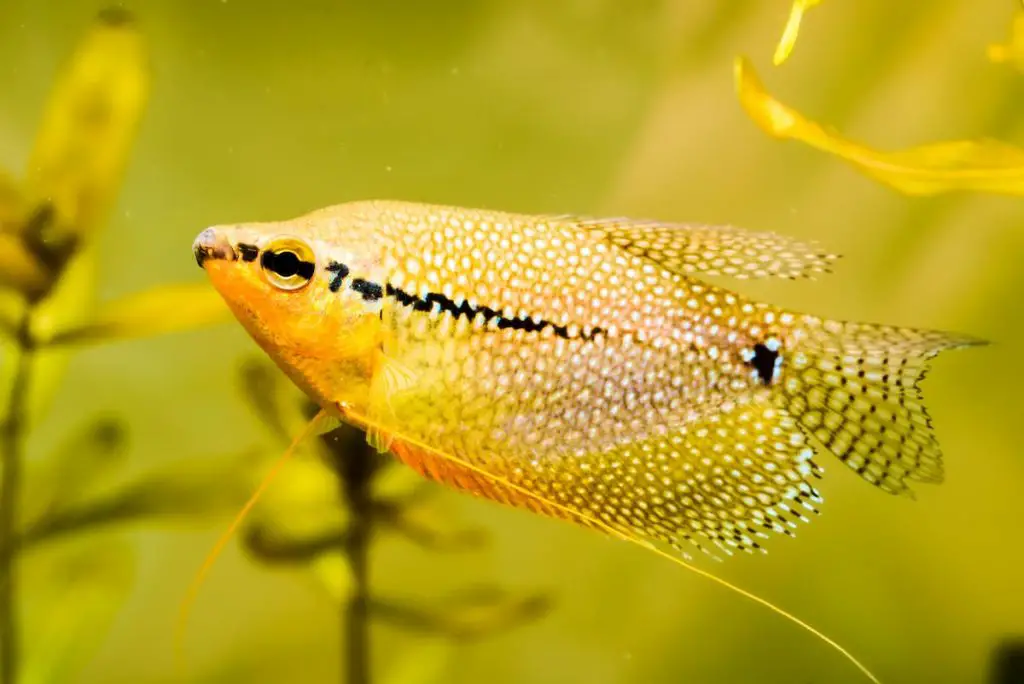
Pearl Gourami are known for being bubble nest builders. The male of the species will blow a lot of bubbles when they are looking for a mate. The bubbles they send out will float to the surface of the water.
Bubble nests are a collection of bubbles that have been blown to the surface. The bubbles are coated with fish saliva to make them durable for building.
The nest itself acts as a safe place for the fish to deposit their eggs. With Pearl Gourami living in the wild, this takes place in the water shallows to avoid predators that are too big for reaching the more shallow part of the water.
After this species of fish has courted and spawned, the fertilized eggs are released and float up into the bubble nest. The male’s job is to protect the nest against fish who would try to eat the eggs.
After one or two days the eggs will hatch.
After about five days the fry will start to swim around. While the adults have a labyrinth organ that requires them to breathe air, the fry has fills that allow them to survive until they can mature and be big enough to survive on their own.
This species of fish Is easy to breed in captivity. Most of the techniques and tricks you would use for helping to encourage fish breeding applies to this one.
For having the least amount of complications it is best to have a separate tank set up for breeding. Once you have It ready then you can place the fish you are wanting to mate together in it.
Most fishkeepers suggest having one male and several females to help encourage breeding.
In the lead up to make, make sure to feed your fish high-quality fish food. Increase the temperature of the water up to 82°F, but not a higher temperature.
It is also important to make sure to keep your tank clean to reduce any stress the fish may start to feel.
After the bubble nest is built and the eggs are hatched, make sure to remove any of the fish who are not parents to remove any chance of the fry being eaten.
Nutritional Needs
Pearl Gourami are omnivores that can eat a wide variety of food. Despite their willingness to eat many different types of food, it is important to make sure they consume a balanced diet.
Top tip: As this fish will eat anything, it is important to only feed them nutritional things. Otherwise, they’ll not make the healthy food choices for themselves and just eat junk as it becomes available to them in the aquarium.
In nature, this species of fish are happy to eat food that is rich in protein such as insects, eggs, and algae.
One of the many reasons they live in plant-rich areas is because they will eat plant matter when there is no readily available source of protein.
In captivity, the fish species should be given a steady diet of a base food such as flake food or feeding pellets. To help the fish maintain good health it helps to mix in some live food with their regular feedings.
Besides the additional nutrition feeding, live food will help to trigger your fish’s hunting instinct and help them have reduced stress levels.
When you have fry, they will especially do well if fed infusoria.
They’ll love you if you feed them:
- Low or no grain flakes or pellets
- Brine shrimp
- Freeze-dried or live bloodworms
- Zucchini
- Glass worms
- Black worms
- Insect eggs
- Insect larvae
- Brine shrimp eggs
| Best Sustenance Food Type: | Insect larvae, brine shrimp eggs, combined with low or no grain flakes |
| Additional Food For Optimal Health: | Protein-rich foods and plants and vegetables, like algae wafers and zucchini |
| Special Foods and Considerations for Best Color and Growth: | Brine Shrimp, Bloodworms, Blackworms, Glass worms |
| When and How Often to Feed Fish Based on Life Cycle: | Two to three times a day. |
Common Diseases and How to Avoid and Treat Them
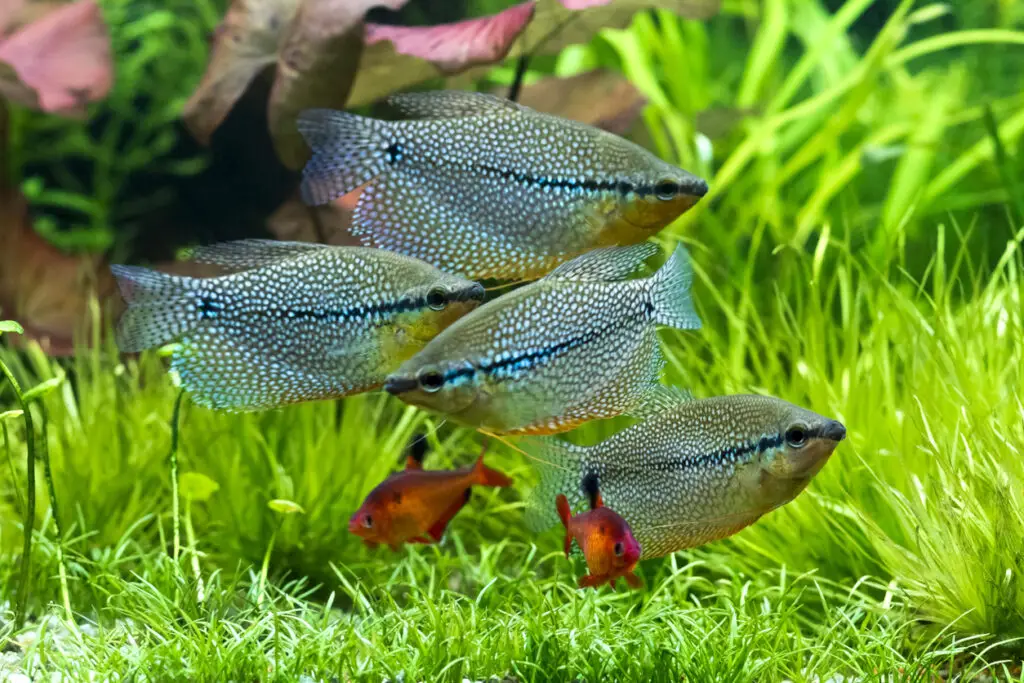
The Pearl Gourami is a durable fish species that aren’t as vulnerable to ailments common to a lot of fish. The one common fish ailment it is highly vulnerable to is fin rot.
Fin rot is a bacterial disease that causes the fish fins to rot. After the fish is infected the edge of the fin is the first part to rot as it starts to work its way inward.
If this disease is left untreated then it will progress to the body of the fish and it will eventually die.
While it is possible to treat fin rot in an infected fish, the best course of action is to prevent the disease from occurring in the first place.
Author note: As this disease is caused by having poor quality tank water, it is easily prevented by maintaining and taking care of your aquarium and changing the water regularly.
If you change the water at least once a week and wipe away any growing algae, this should be enough to help keep your fish healthy.
If your fish does contract fish rot, it is important to change the water immediately and isolate the fish to help stop the disease from spreading to another fish.
With the sick fish in isolation, you can add antibacterial medication to the water to help it heal and recover.
| Best Antibiotics: | Antibacterial medications for freshwater tropical fish |
| Treatments to Avoid: | Nothing of note |
| Food Recommendations When Sick: | Protein-rich foods and extra zucchini and algae wafers |
| Hospital Tank or Isolation Withing the Community Tank: | You should always isolate fish when they become ill, or the rest of the tank may become infected as well. |
4 Facts About Pearl Gourami
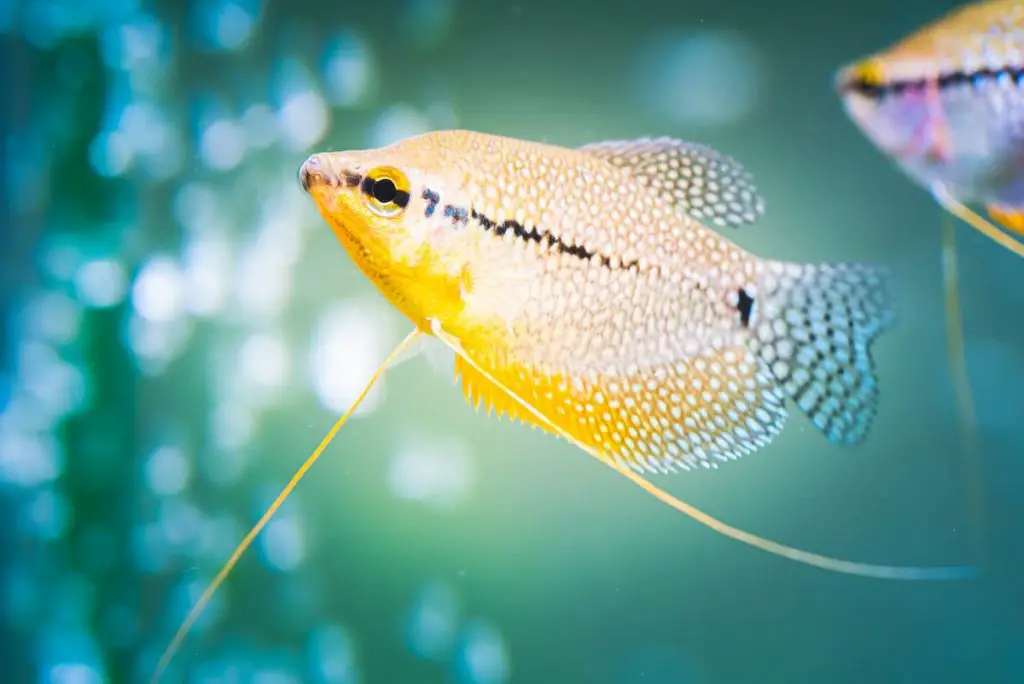
- Pearl Gourami is one of the more attractive Gourami and is both hard and easy to keep.
- It’s pearl and brown colored flecks across the fish’s scale is the origin of its name. They also have black lines from mouth to tail.
- This is a labyrinth fish that requires the need to get air by gulping it from the top of the tank.
- As with other labyrinth fish, the Peal Gourami is capable of vocalizing and is known to talk by using croaks and growling noises, especially during the breeding season.
Pearl Gourami FAQs
Are pearl gourami carnivores?
Pearl gourami are actually omnivores, not carnivores, meaning they eat both animal and plant matter.
This means that they require a well-balanced diet of both plant matter (veggies, leaves, etc.) and proteins like seafood and insects.
Should pearl gourami live alone?
Technically, yes, you can keep a single pearl gourami on its own.
However, they do prefer at least a few of their own species in their homes, despite not being a schooling fish.
Can pearl gourami safely live with shrimp or will they eat them?
Pearl gourami may occasionally eat a shrimp if they live in an aquarium together. If you have faster shrimp species, however, this is less likely to happen.
A good ratio for keeping pearl gourami is 1 male to every 3 females.
Are pearl gourami aggressive?
No, pearl gourami fish are a peaceful species. They’re typically happy on their own and won’t mess with the other fish and creatures in their aquarium.
